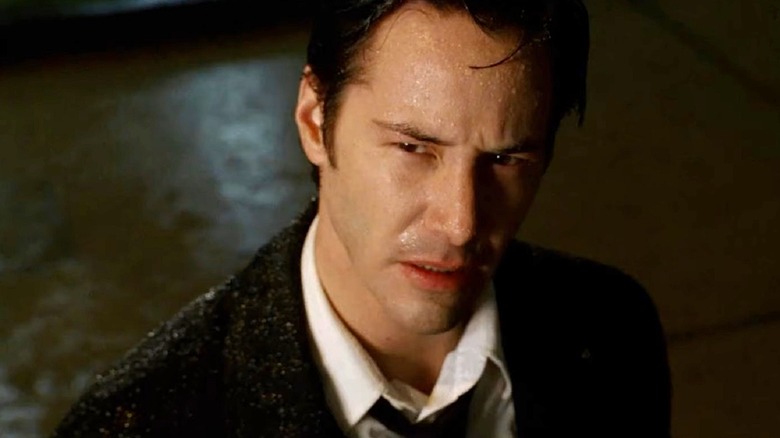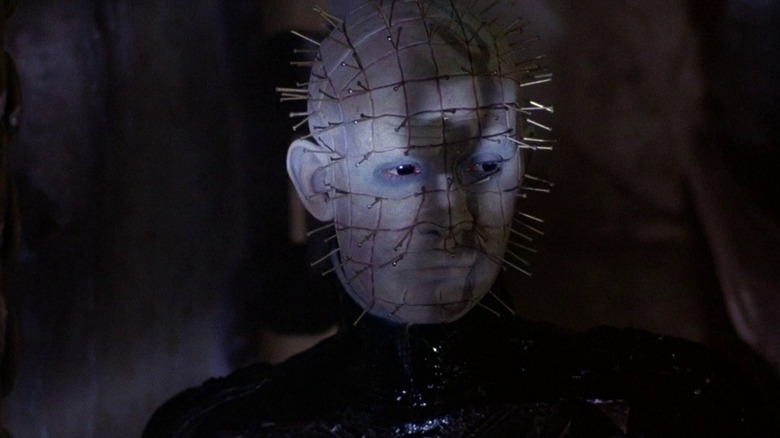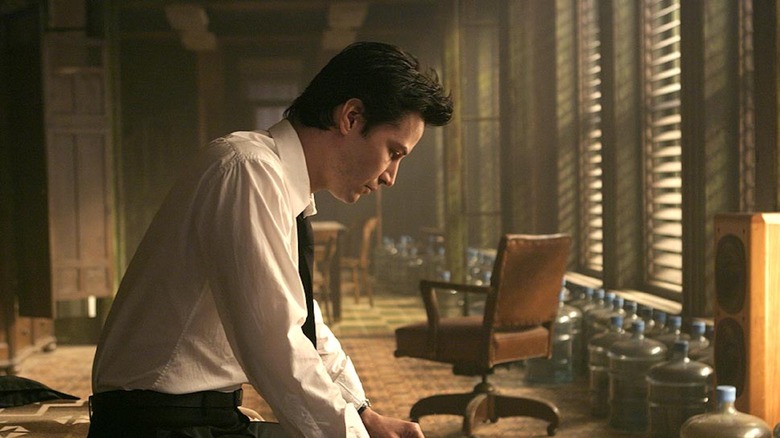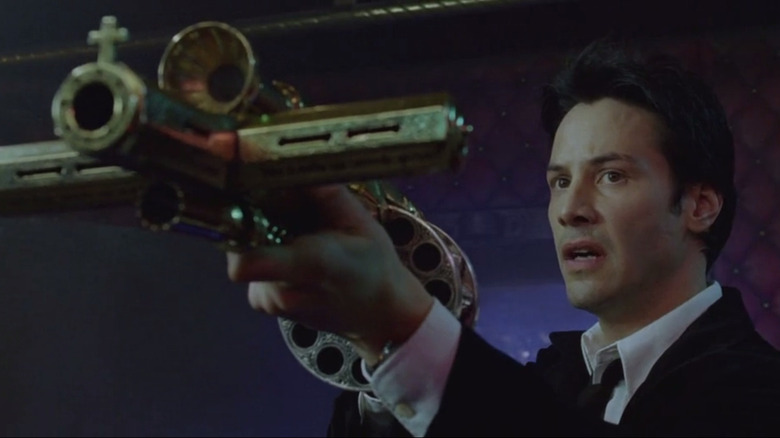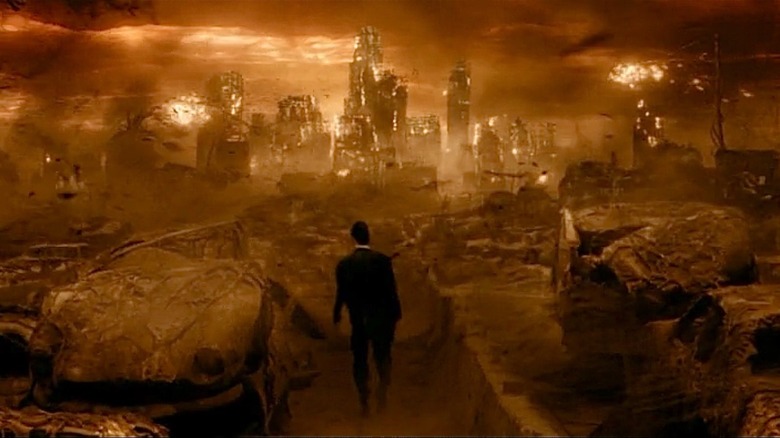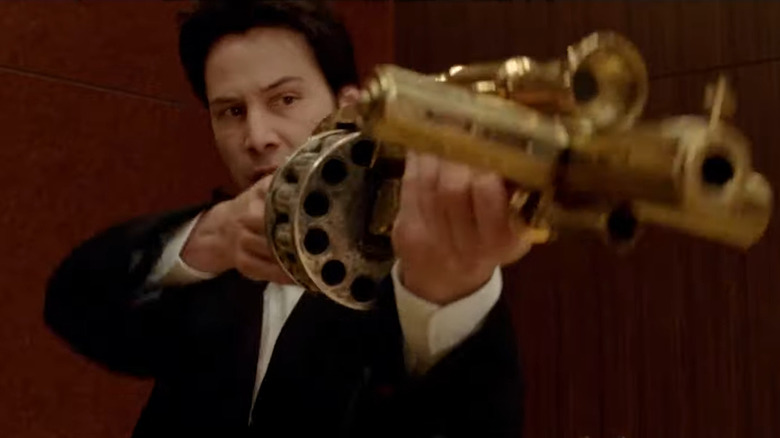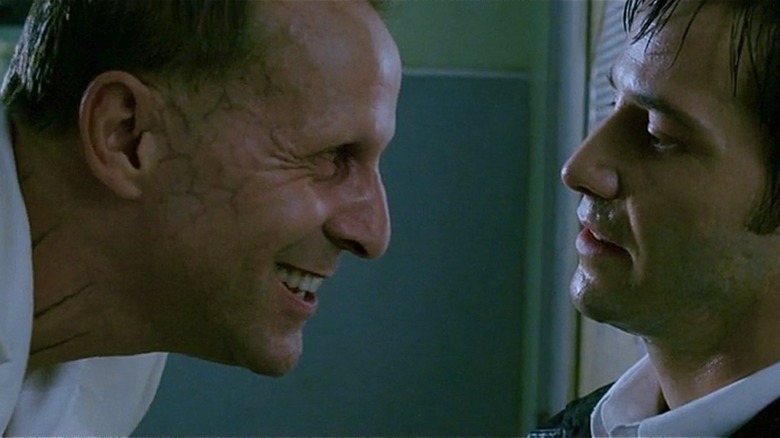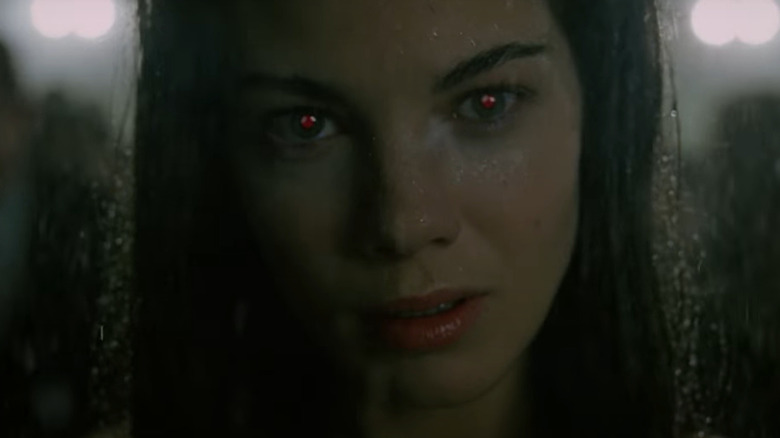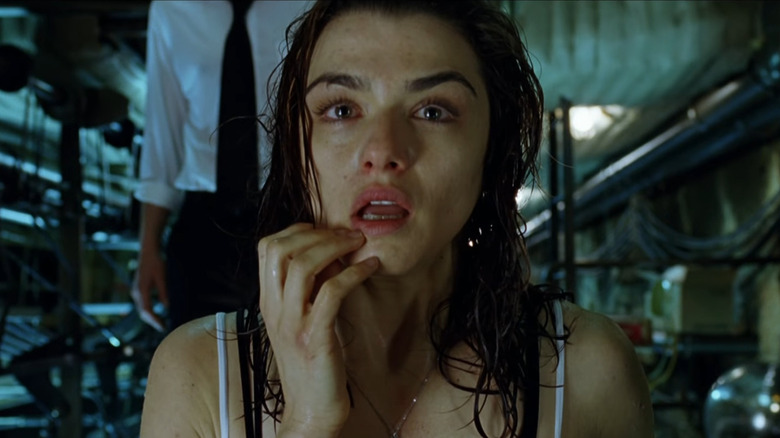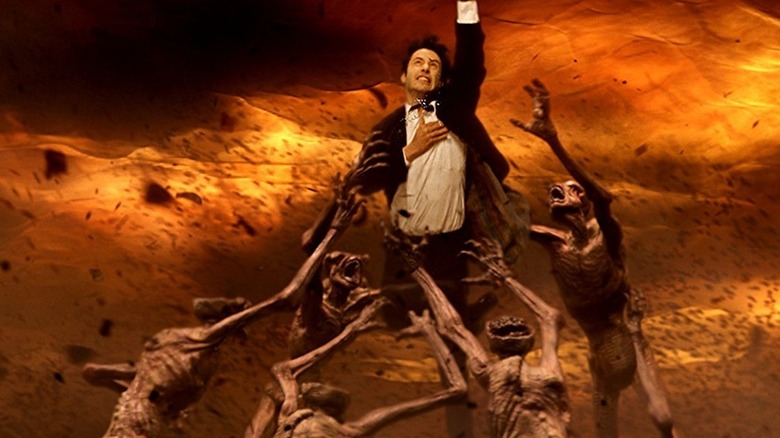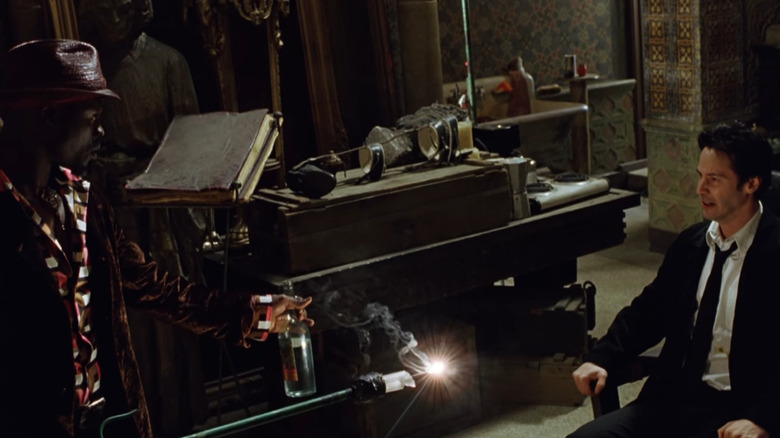The Untold Truth Of Constantine
Superhero movies are often praised for being adaptable to a host of different genres. You can make a superhero movie that functions as a political thriller like "Captain America: The Winter Soldier," a psychological drama like "Joker," a family comedy like "The Incredibles," or a gritty neo-Western like "Logan."
However, one genre that superhero movies rarely dip their toes in is horror. Of course, there are a few notable exceptions to this rule, a la "Blade" and "Doctor Strange in the Multiverse of Madness." Perhaps the most fun entry in the superhorror canon is 2005's "Constantine." Based on the character who first appeared in "Swamp Thing" before conjuring up his own series, "Constantine" follows Keanu Reeves as the titular cynical necromancer who must protect the world from the son of Satan. While the film was savaged by critics at the time of its release and has never been beloved by diehard comic book fans, the film has found a cult following since its release — largely thanks to its impressive visuals, fun worldbuilding, and jaded lead performance by Keanu Reeves.
And like John Constantine descending into a world of fallen angels and dangerous spirits, we're going to take a deep dive into the making of this unique film. From the actor who almost played the antihero to its largely improvised climax, here's the untold truth of 2005's "Constantine."
Nicolas Cage as Constantine?
John Constantine first started gaining popularity in the early '90s, and the film industry immediately jumped at the idea of making a movie about a butt-kicking, wise-cracking exorcist with an inbuilt fanbase. But before Keanu Reeves signed onto the project, it was looking like the movie was heading in a very different direction.
In the late '90s, producer Lauren Shuler Donner secured the rights to the comic book character and set about the task of bringing his escapades to the big screen. Donner bought in filmmaker Paul Hunter to pen the script and eventually direct it. By 2001, Hunter had been replaced by Tarsem Singh as the directorial voice of the project, and Nicolas Cage was set to play the role of Constantine.
The film was supposed to begin shooting in 2002. Unfortunately, Singh decided to walk away before filming could begin, with The Hollywood Reporter (via IGN) saying that the filmmaker had left due to budgetary reasons. As for Cage, he was eventually replaced by Keanu Reeves, who would star in the 2005 film, directed by Francis Lawrence. Of course, while Reeves is fantastic in the role, we can't help but wonder what it would've been like to see Nicolas Cage blasting demons with a holy shotgun.
The other Hellraiser
The world of John Constantine is placed squarely within the realm of angels and demons, following their interactions with ordinary humans once the gates of Hell are raised by mortals. "Constantine" is hardly the first movie to explore this world. In fact, the filmmakers had to go out of their way to make sure audiences didn't confuse their movie with a similarly themed franchise.
At the time that "Constantine" was struggling to get made, the "Hellraiser" franchise — featuring the iconic slasher movie villain Pinhead – had already established a large fanbase. Not only do Pinhead and Constantine operate within similar worlds exploring human desire and its corruption by demons, but the exorcist's comic series was originally known as "Hellblazer." As a result, the movie's name was changed to avoid people thinking "Constantine" was part of the similar-sounding "Hellraiser" franchise, as director Francis Lawrence explained to About.com.
Interestingly, this mirrors what happened with the first comic series featuring John Constantine in the lead. The series was intended to be called "Hellraiser" as a reference to John opening the gates of Hell. But since the Pinhead-led franchise had already become popular, the comic series' title was changed to "Hellblazer." Come to think of it, a face-off between John Constantine and Pinhead would make for a pretty sweet horror movie.
Constantine was disowned by the creator
Before making his way to the big screen, John Constantine was a mere figment in the imagination of legendary comic book creator Alan Moore. Of course, Constantine was far from the only character Moore created who went on to gain a Hollywood adaptation. Most notably, he's the mind behind "Watchmen" and "V for Vendetta" ... although he doesn't particularly care for the films.
But even before "Constantine," Moore had already had a few of his comics adapted for the big screen, including "From Hell" and "The League of Extraordinary Gentlemen." The films released to mixed reviews, but there was nothing mixed about how they were viewed by Moore. He openly hated the way his creations were adapted by the film industry, and he was allegedly so dissatisfied with the way "Constantine" was being made that he refused to receive compensation or have his name on the screen in the film's credits.
This would hardly be the last time that Moore would express disapproval for a live-action adaptation of one of his comic book creations. But in the case of "Constantine," Moore's dissatisfaction is understandable given how wildly the movie diverges from its source material and, in the process, almost becomes its own separate beast.
Nothing like the comics
There's a strange irony in the fact that the "Constantine" movie was made because the character proved to be hugely popular in the comics. How so? Because the live-action version of John Constantine who shows up in the film bears little resemblance to his comic counterpart beyond being set in a similar world operating between Heaven and Hell.
In the comics, Constantine is a blonde-haired Brit in a brown trench coat who looks like Sting, with a prominent British accent and mainly operating out of London. All of this was changed once Keanu Reeves was brought on board to play the character, as he became a black-haired American who lives in Los Angeles. Given Reeves' status as an action star, his version of Constantine also has a lot more weapons, unlike in the comics where Constantine is mainly known for using his knowledge and cunning to double-cross and defeat supernatural forces.
The movie version of Constantine also has a natural ability to perceive demons, which made him attempt suicide, damning his soul to Hell. In the comics, the big, tragic moment in Constantine's life comes after the botched exorcism of an innocent girl, which sets him down a dark path. Finally, the movie has Satan willingly bringing Constantine back to life during the climax, while Constantine tricks him into doing so in the comics.
If you or anyone you know is having suicidal thoughts, please call the National Suicide Prevention Lifeline by dialing 988 or by calling 1-800-273-TALK (8255).
A nuclear hellscape
It can be easy to forget that "Constantine" is technically a superhero movie because its aesthetic is so different from anything else within the genre. The filmmakers took the gritty and grounded approach to John Constantine's comics deeply to heart and injected the same qualities into the cinematic world John inhabits.
On the surface, John operates in a grimy, bleak version of L.A. that always looks a little washed out and depressing. But what's lurking underneath is much worse. In a memorable sequence, John opens the gates of Hell to take a walk in Satan's domain. This version of Hell looks devastatingly alien yet also horrifyingly familiar because the artists behind its design looked to real life for the bleakest inspiration.
"We started to look at the nuclear test films from the 1940s of the nuclear blasts [for inspiration]," director Francis Lawrence explained to Horror.com, adding, "We decided that it was kind of an eternal nuclear blast, except nothing ever really gets obliterated because it's eternal and it's constantly going." Quite a chilling rendition of eternal damnation, and it also ties into the movie's themes that Heaven and Hell are of humanity's own making through their choices.
A piece of religious history
The movie "Constantine" reimagines the character from the comics as a butt-kicking action hero who has no problem waging all-out war against the forces of Hell. But how can a mere mortal possibly harm demons and Satan's minions? With the help of specially made weaponry that contains bits and pieces of holy objects touched by God.
In one of the film's early scenes, Constantine is trying to convince Detective Angela Dodson (Rachel Weisz) of the existence of Heaven and Hell when they're attacked by a horde of demons. While Angela draws her gun, Constantine knows something more divine is needed to defeat such powerful enemies. He whips out a piece of cloth, wraps it around his hand, and sets it on fire. The demons are destroyed by the light coming from the shroud because the fabric once belonged to Moses, as Keanu Reeves explained in an interview reported by Whoa Is (Not) Me.
In addition to Dragon's Breath and balls filled with holy water, Constantine is also armed with some serious firepower. As Reeves explained, "I put together this 'holy shotgun', which again I think is kind of fun. 'Killing with God.' ... Out of a cane, a clock, and this hand sword, I pull together these pieces that go back together to create the holy shotgun."
A different look for the devil
One of the highlights of "Constantine" is its distinctive take on Satan, played by Peter Stormare. All through the movie, Satan remains someone who's referred to by other characters with great fear, but he's not actually seen for the longest time. He finally makes his grand entrance near the climax to personally drag a dying Constantine to Hell after years of the exorcist evading him.
When the Lord of Darkness finally appears, he looks deceptively ordinary — a middle-aged man with a polite demeanor and black gunk sticking to his feet. But the moment he starts talking, you understand why this creature is the ruler of Hell itself. Stormare's performance, as he goes from harmless to menacing, is helped along by his costume, which the actor had a hand in crafting for the scene. In fact, he took it in a very different direction from what the filmmakers had originally intended.
"When I did costume fittings it was leather pants, bare-chested," Stormare told The A.V. Club. "I had, like, a dog collar with spikes. I had punky hair. I had [CGI] tattoos on my face, all over my chest." Unconvinced, Stormare told the producers of the film that the exotic getup would distract audiences from what Satan had to say to Constantine. The actor finally convinced them to put the devil in an "off-white linen suit" with tar dripping from his feet.
Constantine's missing demon lover
"Constantine" shows its lead character as a bitter, cynical loner who doesn't have any friends or allies beyond the people who help him with his job. But the character wasn't so completely isolated when the film was being shot — Constantine had a demon lover who was removed from the final cut of the film.
Michelle Monaghan would've played the role of Ellie, a half-breed demon who's in a relationship with Constantine. Originally, Ellie was going to pop up at various points in the movie, including when she meets her boyfriend at a night club. Ellie would've had a complex relationship with John, seeking out his company while also taunting him about his impending death via cancer. However, most of the scenes featuring Ellie were removed from the theatrical cut of the film.
"We just decided that Constantine was better alone," said director Francis Lawrence (via Screen Rant), "and feeling like he didn't have a companion that he could, sort of, lean on and have a relationship with." However, Ellie does show up in the theatrical cut in the scene at the hospital where holy water is sprayed on a group of demons.
A hard shoot for Rachel Weisz
While "Constantine" sees the titular John Constantine in the lead role, the story is really about Rachel Weisz's Angela Dodson, who's an L.A. homicide detective racked with pain over the death of her twin sister. As Angela investigates the truth about her sister's demise with Constantine, she uncovers a vast demonic conspiracy to take over the world.
The role of Angela is a tough one to crack, and Weisz had to do a number of unpleasant things to get under the skin of her character. In order to convincingly portray a homicide detective, the actress visited her character's places of work in real life, accompanied by an ex-cop. "He took me to the firing range," Weisz explained to IGN, "and took me to the morgue." But the toughest part of the role was shooting the scene in which Constantine holds Angela underwater in a bathtub to the point of near-death.
In the same interview, Weisz explains that she had worked out a signal with Keanu Reeves to let her up if she tapped him three times on the arm. But since her character was supposed to be thrashing around in the bathtub anyway, Reeves couldn't determine whether she was acting or actually asking to be let up. "There was a moment there in which I was really not acting anymore," the actress recalled. "I was just trying to get out of the bath." Fortunately Reeves pulled her up just in time.
The accidental R-rating
When "Constantine" first came out, it was an unusual outing for a superhero movie at the time because the film was rated R back when every other entry in the genre was PG-13. As it turns out, the makers of "Constantine" had every intention of making a PG-13 movie, but they still landed with an "R" rating because of the tone of the film.
"[Warner Bros.] ... dictated that [the movie] had to be PG-13 because of what it cost," director Francis Lawrence explained (via Collider). "And we actually got this sort of list of guidelines of what you can do and what you can't do in a PG-13 movie. And we followed those rules to a T." The filmmakers made sure not to overdo the blood, violence, or profanity shown in "Constantine" in accordance with the rules set by the censor board.
Unfortunately, Lawrence revealed that when they finally screened the movie for the censors, five minutes into the story they decided to give "Constantine" an R rating. "We got a hard R for 'tone.'" says Lawrence. "And so this is not something that's on the list." Basically, the feeling of fear and dread that "Constantine" invoked within the censors without an overuse of blood, gore, or overt horror was such that they felt compelled to hand out the R rating.
The climax had a lot of improv
Most superhero movies end with a big CGI battle against the main villain, full of explosions and crashes and any other thing to make the climax epic. "Constantine" goes a different route by having the final showdown between John Constantine and Satan be a battle of wits instead of a physical combat.
As Constantine is dying, Satan comes to gloat over finally getting to take him to Hell. After a few tense verbal exchanges, Constantine manages to convince Satan to save his life. It's a thrilling scene made compelling by the dialogue and performances of the two actors involved, and a lot of the things you see were actually improvised by the actors to dig deeper into the scene.
"A lot of the lines are improv," Peter Stormare told The A.V. Club about playing Satan opposite Keanu Reeves' Constantine in the scene, "or during rehearsals we came up with dialogue, me and Keanu." According to Stormare, the core of the scene was already present in the script, but he and his co-star took it much further while rehearsing their lines. The improv is one of the reasons the final scene feels so organic, and you can actually feel the animosity buried under fake civility as Constantine and Satan face off against each other.
Growing calls for a Constantine sequel
"Constantine" arrived with much fanfare in theaters in 2005, but that fanfare didn't last long. The film received mixed reviews from critics, the core fan base from the comics didn't like the changes to the source material, and general audiences didn't know what to make of an exorcist wielding a cross-shaped shotgun.
While the movie didn't earn enough money to greenlight a sequel at the time, it's made a better impression upon repeat viewing. In recent years, "Constantine" has come to be regarded as a cult classic, and its fans have started asking for a sequel. Director Francis Lawrence is on board with the idea, telling MTV in 2011, "We should do the hard-R scary version, which I would love to do."
Fans also want to see Keanu Reeves reprise his role as the black-haired, American version of John Constantine, and the actor hopes to fulfill that wish some day. "I would love to be John Constantine again," Reeves told Stephen Colbert in 2021 (via EW). Finally, Peter Stormare posted a photo of Satan from "Constantine" on Instagram in 2020 with the caption, "Sequel in the works." Hopefully so much collective goodwill will finally convince the studio to bankroll the sequel as John Constantine starts becoming a more prominent part of pop culture.
